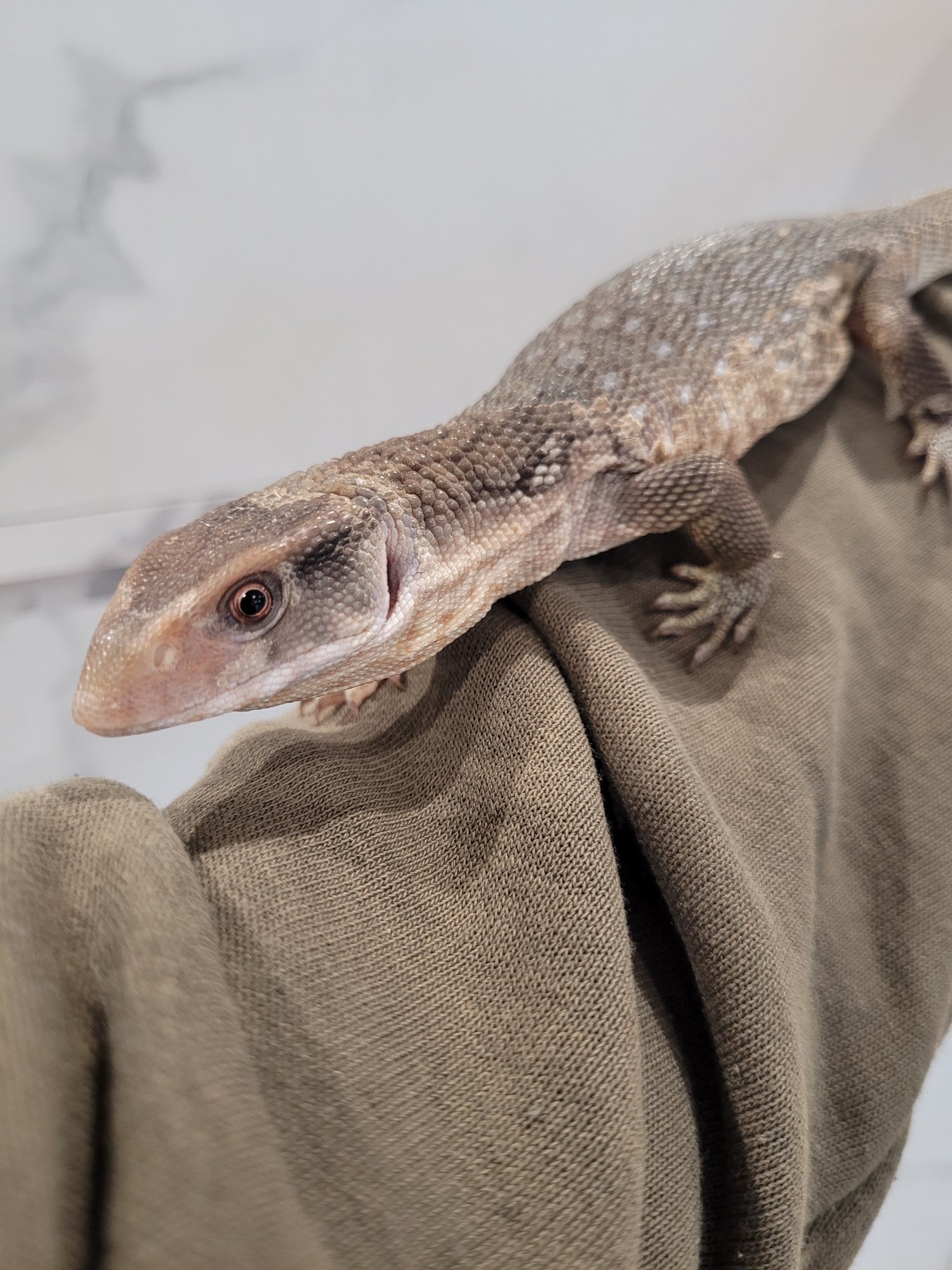
Bosc Monitor
Care
Lifespan
The sad truth is that unfortunately a lot of Bosc Monitors in captivity die far too young, often not surpassing 2 to 6 years of age. This is largely due to misinformed owners who are relying on incorrect and outdated care information that is passed on when researching, particularly when it comes to diet, humidity and general husbandry. In fact, 99.9% of health problems faced by captive Bosc Monitors are husbandry related.
Adult size
Bosc monitors have the ability to reach 5ft in total length.
Housing
Largely originating from the grasslands (savannahs) of Ghana Africa, they roam freely during the day and dig deep burrows for shelter. For this reason, the minimum recommended size requirement for an adult sized monitor is an 8x4x4ft (LxDxH) sealed wooden enclosure.
Many keepers recommend housing them in this sized enclosure as soon as possible due to their fast growth rates and high activity levels. If you are able to provide more space than the minimum requirement then this will be beneficial, particularly height as they can be avid climbers.
Heating
Bosc monitors are quite susceptible to burns when adults because they are known to press up against their basking bulb in an attempt to heat up all areas of their large body. To avoid this, the best way of heating the enclosure is to use multiple lower wattage basking bulbs (50-100w floods) set up in a row on one side of the enclosure instead of one lone high wattage basking bulb.
This will increase the size of the basking area and allow the monitor to heat up its full body evenly. We recommend that temperatures are measured with a reliable thermometer.
Basking surface temperatures need to be in the range of 130-140F (54-60C). Hot end ambient temperatures need to be 90-100F (32-37C). Cool end ambient temperatures need to be 75-80F (23-26C).
Lighting
Ghana has a very high UV index, so the use of a UVB bulb to replicate this in the enclosure is essential. We recommend the use T5 12/14% UVB bulbs mounted across the ceiling of the enclosure.
We recommend that all heating and lighting should be placed on a 12 hour light cycle with the use of timer switches (for example, everything on at 8am every morning and everything off at 8pm every night).
The temperature at night will therefore drop as it would in the wild, and unless the enclosure is situated in a particularly cold room, no supplemental night-time heating is required.
Humidity
In their natural habitat, described as tropical, humidity ranges from 65% to almost 100% within their burrows. Misinformed owners have often overlooked this aspect of a Bosc monitor’s husbandry and have provided an enclosure that is kept too dry.
We recommend the use of a reliable digital hygrometer to measure humidity, which should be maintained at varying levels above 65% in different parts of the enclosure.
Having a thick layer of substrate helps to provide this, as humidity will be retained in its depths. Conditions should never be kept constantly wet and substrate should not become waterlogged or soggy. Allow humidity to drop back down to 65% between mistings.
Substrate
We recommend that substrate is a deep (18-24”) layer of a soil/sand mixture which will allow for the digging of burrows and the retention of humidity. Substrate depth is especially important for mature female Bosc Monitors who can lay clutches of eggs without the presence of a male and should therefore be offered nesting opportunities to avoid reproductive issues.
Hides should be provided in the form of flat cork pieces, although they will often create their own burrows. Enriching decor can include climbing branches, logs, rock pieces (slate rock is useful under the basking area to create a basking surface), dry leaf litter, cork rounds, artificial plants and safe live plants.
Water
We recommend the use of a large water bowl with clean fresh water within the enclosure at all times to allow bathing and drinking. Placing this bowl towards the hotter end of the enclosure helps to maintain humidity and also prevents the water becoming too cold which can lead to drowning if they fall asleep submerged (especially with young monitors).
Diet
The bulk of a Bosc Monitor’s diet should consist of gut loaded insects. These monitors quickly suffer from obesity and fatty liver disease when given an incorrect diet made up of various rodents, chicks and meat.
Research has been carried out to investigate the wild diet of these monitors where the stomach content was examined. For an adult specimen it was found to consist of 49.4% millipedes, 0.1% scorpions, 9.1% crickets and locusts, 3% lizard eggs, 15.1% larvae, 2% snails and 21.2% beetles (savmon.org).
Similar evidence of an insect based diet was found in all other specimens of various size and age. This should be replicated in captivity by providing a diet of various size-appropriate.
We recommend a supplement schedule of dusting food items with a calcium supplement during the week and a vitamin supplement during weekends. Both of these supplements should not contain vitamin D3 when UVB lighting is provided (overdose can occur when D3 is given in conjunction with UVB lighting).
Other food items such as raw Quail eggs (broken shell), whole fresh fish cut into chunks and rodents/chicks should only be offered occasionally.
